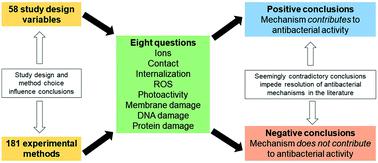当前位置:
X-MOL 学术
›
Environ. Sci.: Nano
›
论文详情
Our official English website, www.x-mol.net, welcomes your
feedback! (Note: you will need to create a separate account there.)
Towards resolution of antibacterial mechanisms in metal and metal oxide nanomaterials: a meta-analysis of the influence of study design on mechanistic conclusions
Environmental Science: Nano ( IF 5.8 ) Pub Date : 2020-11-24 , DOI: 10.1039/d0en00949k Eva Albalghiti 1, 2, 3, 4 , Lisa M. Stabryla 4, 5, 6, 7 , Leanne M. Gilbertson 4, 5, 6, 7 , Julie B. Zimmerman 1, 2, 3, 4, 8
Environmental Science: Nano ( IF 5.8 ) Pub Date : 2020-11-24 , DOI: 10.1039/d0en00949k Eva Albalghiti 1, 2, 3, 4 , Lisa M. Stabryla 4, 5, 6, 7 , Leanne M. Gilbertson 4, 5, 6, 7 , Julie B. Zimmerman 1, 2, 3, 4, 8
Affiliation

|
While the antibacterial potency of metal and metal oxide engineered nanomaterials (MMO ENMs) has been well-established in the literature, the underlying mechanisms of antibacterial activity are regarded by many as uncertain, despite a considerable volume of publications on this subject. In order to illuminate sources of perceived uncertainty and disagreement, 318 articles pertaining to the mechanism of antimicrobial activity of Ag, Cu, CuO, TiO2 and ZnO ENMs were analyzed. The 318 studies all aimed to assess one or more of eight mechanistic questions, and both positive (i.e. affirmative) and negative conclusions were reported for each mechanistic question for each of the five core compositions. Differences in study design, including the exposure conditions and experimental methods used, were found to statistically significantly correlate with differences in reported mechanistic conclusions. Further analysis of studies which investigated two or more mechanisms revealed how assumptions about which mechanisms predominate for a given core composition may influence study design and, in turn, conclusions. Finally, 181 distinct experimental methods were identified, many of which are relatively untested and have not been evaluated in the published literature, while many frequently-used methods were found to have limitations that may obscure interpretation and mechanistic insight.
中文翻译:

试图解决金属和金属氧化物纳米材料中的抗菌机制:对研究设计对机械结论的影响的荟萃分析
尽管金属和金属氧化物工程纳米材料(MMO ENMs)的抗菌能力已在文献中得到充分确立,但尽管有大量关于该主题的出版物,但许多人仍认为其抗菌活性的潜在机制尚不确定。为了阐明感知到的不确定性和分歧的来源,分析了涉及Ag,Cu,CuO,TiO 2和ZnO ENMs的抗菌活性机理的318篇文章。318项研究均旨在评估8个机械问题中的一项或多项,并且均为阳性(即对于五个核心构成中的每一个,每个机械问题都报告了肯定和否定的结论。研究设计的差异(包括所用的暴露条件和实验方法)被发现与报告的机械结论的差异在统计学上显着相关。对研究两种或两种以上机制的研究的进一步分析揭示,对于给定的核心组成,哪些机制占主导的假设可能会影响研究设计,进而影响结论。最后,确定了181种不同的实验方法,其中许多方法尚未经过测试,尚未在已发表的文献中进行评估,而许多常用方法的局限性可能会掩盖解释和机械原理。
更新日期:2020-12-17
中文翻译:

试图解决金属和金属氧化物纳米材料中的抗菌机制:对研究设计对机械结论的影响的荟萃分析
尽管金属和金属氧化物工程纳米材料(MMO ENMs)的抗菌能力已在文献中得到充分确立,但尽管有大量关于该主题的出版物,但许多人仍认为其抗菌活性的潜在机制尚不确定。为了阐明感知到的不确定性和分歧的来源,分析了涉及Ag,Cu,CuO,TiO 2和ZnO ENMs的抗菌活性机理的318篇文章。318项研究均旨在评估8个机械问题中的一项或多项,并且均为阳性(即对于五个核心构成中的每一个,每个机械问题都报告了肯定和否定的结论。研究设计的差异(包括所用的暴露条件和实验方法)被发现与报告的机械结论的差异在统计学上显着相关。对研究两种或两种以上机制的研究的进一步分析揭示,对于给定的核心组成,哪些机制占主导的假设可能会影响研究设计,进而影响结论。最后,确定了181种不同的实验方法,其中许多方法尚未经过测试,尚未在已发表的文献中进行评估,而许多常用方法的局限性可能会掩盖解释和机械原理。











































 京公网安备 11010802027423号
京公网安备 11010802027423号